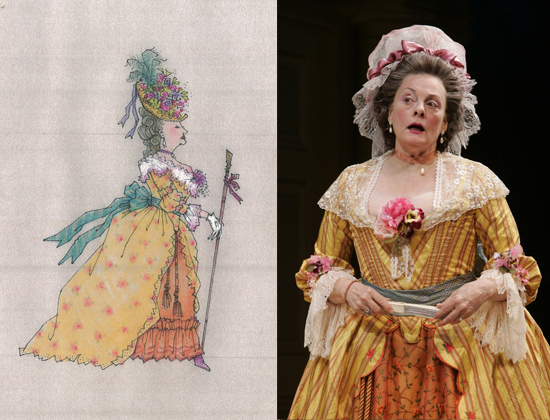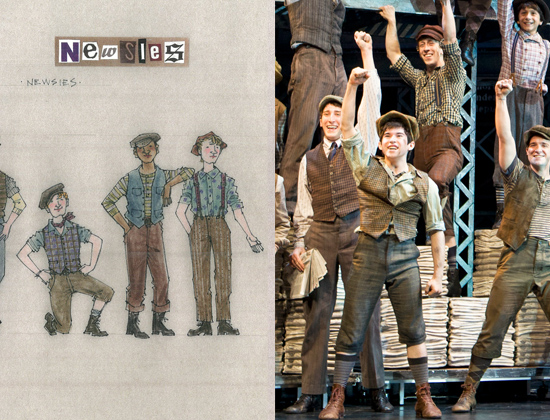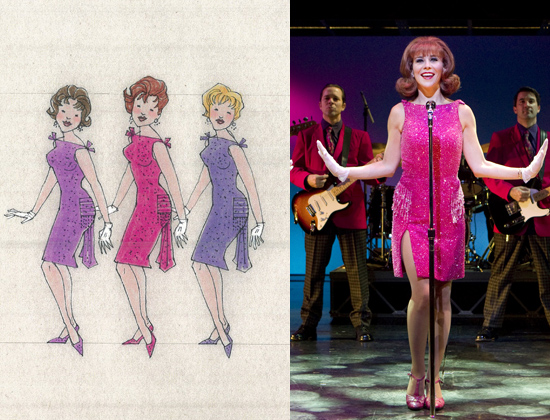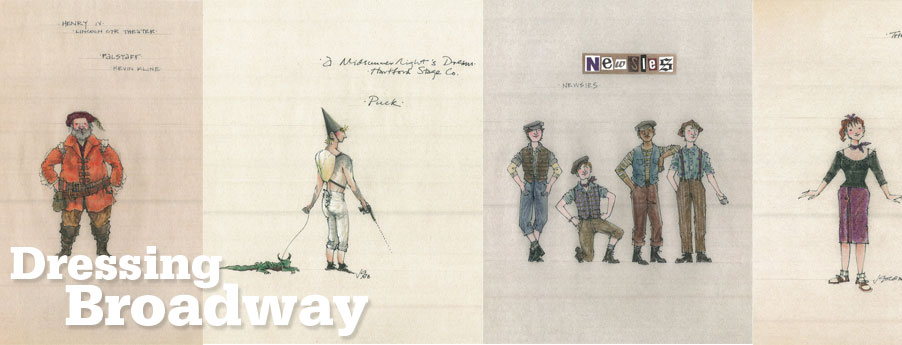Dressing Broadway
Tony Award–winning costume designer Jess Goldstein looks back on a career spanning English petticoats and Hollywood glam.
By Andrew Thurston; Sketches by Jess Goldstein
With well-placed stitches and carefully chosen swatches, Jess Goldstein (’72) ensures the stars on Broadway do more than act the part—he makes sure they look it, too. When it comes to costume design, Goldstein is A-list. He’s outfitted dozens of movies and smash Broadway shows, including the long-running Jersey Boys and the critically acclaimed 2011 Disney production, Newsies. A three-time Tony Award nominee (and winner for period comedy The Rivals), Goldstein has worked with such stars as Al Pacino, Kevin Kline, and Kristin Chenoweth. Here, he shares some of his favorite designs and the stories behind them.

Mrs. Malaprop, played by Dana Ivey, The Rivals, Lincoln Center Theater, New York City, 2005. Photo by Joan Marcus
1 ] Breeches to Bikinis • From petticoats to Speedos, sometimes in the same night; fortunately, not on the same stage. In 2005, Jess Goldstein was working on two very different plays: The Rivals, a comedy of manners written in the 1770s, and Good Vibrations, the Beach Boys musical. “I was constantly running between fittings of the glorious petticoats and breeches of late-eighteenth-century England,” says Goldstein, “to the wet suits and bikinis of an indeterminate period in Southern Californian culture. I even had to miss The Rivals’ opening night because of dress rehearsals on the other show.” Goldstein’s versatility would be rewarded: he scooped a Tony for his work on The Rivals.

Sir John Falstaff, played by Kevin Kline, Henry IV, Vivian Beaumont Theater at Lincoln Center, New York City, 2004. Photo by Paul Kolnik
2 ] Costume as Storytelling • A well-chosen costume can make the difference between an actor playing a character and becoming him. Despite decades of screen and stage success, Kevin Kline needed Goldstein’s help in 2004 to inhabit Falstaff, the bloated, errant knight of Shakespeare’s Henry IV plays. “Kevin was incredible as Falstaff,” says Goldstein, “but needed constant encouragement that he could make the physical transformation.” Goldstein adds that the production “really allowed me to show off the power of costume design as storytelling. The play shows a cross section of medieval life, from royalty to soldiers to peasants, and I felt I was particularly successful in making what is sometimes thought to be a rather primitive and clumsy period look attractive and sexy to modern eyes.”

Newsies, Paper Mill Playhouse, Millburn, New Jersey, 2011. Photo by T. Charles Erickson, courtesy of the Paper Mill Playhouse
3 ] Extra! Extra! • A so-so movie in the 1990s, Newsies is proving a star performer on the contemporary stage. Goldstein suspects the Disney-backed musical, which tells of newsboys striking in 1899, could be in line for a long Broadway run. “I don’t think I’ve ever had as much fun on a show,” he says. “I didn’t really know what to expect of the young actors in fittings, but they all seemed to love their costumes and often remarked how much they wished people still dressed in those styles.”

Puck (bottom), played by Daniel Tamm, and Oberon, played by Bradley Whitford, A Midsummer Night’s Dream, Hartford Stage, Hartford, Connecticut, 1988. Photo by Jennifer W. Lester
4 ] Yuppie Shakespeare • This isn’t the cheeky Puck of history. For a 1988 production of A Midsummer Night’s Dream, Goldstein was charged with spinning the sprite of Shakespeare’s forests into a character for a “postmodern yuppie world.” In the creative team’s vision of an industrial landscape, the mechanics—the gadgets that drive stage effects, such as putting winged characters into flight—also became part of the wardrobe. “The flying harnesses were difficult to conceal under the skimpy costumes, so they actually became a part of the look,” says Goldstein. “This is an early sketch of Puck that incorporates football pants, dunce cap, and a frankly theatrical hunchback pad.”

5 ] The Silver Screen • Sometimes stage leaps to screen and Goldstein’s designs follow—albeit with some tweaks. When comedic drama Love! Valour! Compassion! became a movie in the mid-1990s, Goldstein was asked to re-create and update his designs from an earlier Broadway production. In both adaptations, the all-male cast rehearses a ballet for an AIDS fundraiser: “The stage version did not allow the men the time offstage to make a full change into real ballet tutus,” says Goldstein. “They could only add tulle skirts and feathered headpieces to the white boxer shorts and tank tops of their previous costume. For the film, we went all out with the traditional classical ballet look. [I wonder if] the original concept wasn’t more interesting.”

Lotty, played by Jayne Atkinson, Enchanted April, Lyceum Theatre, New York City, 2003. Photo courtesy of Jeffrey Richards Associates
6 ] Tricky Twenties • Some eras are easier to re-create than others. The 1920s—the decade in which Enchanted April is set—is considered one of the most challenging, says Goldstein, with frills replaced by unappealing sharp edges. “I feel most historical periods need to be filtered somewhat for modern audiences who may not appreciate a need for museum-quality accuracy,” he says. “For Enchanted April, we tried to give the women’s boxy 1920s shape a little more curve and grace, and we used softer, lighter-weight fabrics for the men’s suits.”

Jersey Boys, August Wilson Theater, New York City, 2011. Photo by Joan Marcus
7 ] Big Man in Town • Wondering if you’ve ever seen a play outfitted by Jess Goldstein? There’s a good chance of it being this one. “Jersey Boys was that rare show that I knew was going to be an enormous hit just from reading the first draft of the original pre-Broadway production script,” says Goldstein. Of all the shows he’s worked on, Jersey Boys, now in its sixth year on Broadway, is one of the best known. Among Goldstein’s favorite Jersey Boys outfits are those worn by the show’s female actors. “There are only three women in the cast, but each plays about twelve different roles. This is my favorite set of their costumes, when they form the Angels to sing ‘My Boyfriend’s Back.’”

8 ] Rags to Riches • A quick-change conundrum: how to turn an actress from smudge-covered chimney sweep to a gold-glimmering star. “Quick changes can be tricky because when they’re really fast—under a minute—they inevitably lead to some sort of a compromise,” says Goldstein. “In The Apple Tree, Kristin [Chenoweth] had a matter of seconds to change from Ella the Manhattan chimney sweep to Passionella, the Monroe/Mansfield Hollywood star and icon; it meant really simplifying her makeup for both looks. Like a true Broadway star, Kristin was fearless!”










